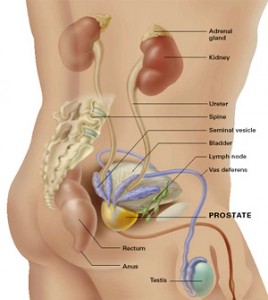(ThyBlackMan.com) More than any other condition, Prostate Cancer comes up more than any other when it comes to the subject of Men’s Health. And the PSA test is most commonly mentioned when it comes to prevention of Prostate Cancer.
The PSA test measures blood levels of a protein made by the prostate. Levels of less than 4.0 (nanograms of protein per milliliter of blood) are usually considered within the normal range, while levels of greater than 4.0 are said to show an increased risk for prostate cancer.
The prostate-specific antigen (PSA) screening test for early prostate cancer has been surrounded by controversy ever since it was introduced. To the surprise of many, there is no proof that the use of this blood test to screen symptom-free men will spare anyone a prostate cancer death. In short,  cancer researchers do not know whether PSA screening saves more lives than it ruins.
cancer researchers do not know whether PSA screening saves more lives than it ruins.
First of all, let me be clear: I’m not against prostate cancer screening.
I’m a tremendous supporter of the real American Cancer Society (ACS) recommendation, which is: Within the physician-patient relationship, men should be offered PSA screening and should be informed of the potential risks, as well as the potential benefits and be allowed to make a choice.
The prostate cancer outcomes from a huge study conducted by the National Cancer Institute, shows that close to 40% of men who undergo a radical prostatectomy (surgical removal of the prosate) will have a PSA relapse within two years.
If you have a group of men diagnosed as a result of PSA screening, 30-40% don’t need to know that they have prostate cancer because it’s meaningless in terms of risk to their health. And for somewhere between 30% and 40% of the men with prostate cancer, no matter what [treatment is given], the disease is not curable. And then maybe there are about 20% who actually benefit. These facts are from clinical studues done by credible researchers from credible instutions.
Men who are screened for prostate cancer are usually relieved when their prostate specific antigen [PSA] levels come back normal. But according to a new study in The New England Journal of Medicine, the results may be misleading.
The study found that 15 percent of the men who had “normal” PSA levels still had prostate cancer. High-grade cancer was found in about 2.3 percent of those so-called “normal” men. It appears that the lower the PSA level, the smaller the risk—the likelihood of having cancer rises as PSA levels rise. But there is no clear PSA level at which a person can be guaranteed cancer-free. Some incidence of high-grade cancer—the most aggressive—was found at every PSA level.
At this point in time, it is not known for sure that having PSA screening actually reduces a man’s risk of dying from prostate cancer.
So how do doctors differentiate between more and less aggressive versions of prostate cancer?
The way the prostate feels. If your doctor can feel the cancer outside the prostate, that’s a bad sign. But most prostate cancers detected today in men who are being screened are confined to the prostate. In those men, the main way they can tell something about the aggressiveness of the cancer is the by Gleason score, or the grade: the appearance of the cancer under the microscope. That can run from a number of 2 to a number of 10—10 being the most aggressive, 2 being the least.
In the United States this year, 1.4 million people will learn they have cancer. So here’s a guide for where to go in the days and weeks following a cancer diagnosis:
1. Get basic information about your cancer
Take notes and ask the questions that will help you understand enough to make good decisions.
2. Pick a doctor (Oncologist and/or Urologist)
Get referrals from friends who have had a similar experience and ask your primary doctor, who would they choose if it was for their son or father.
One of the first things your doctor will do is grade and stage the tumor. These ratings give an indication for how severe and fast-growing the cancer is.
3. Learn how to read your lab reports.
Pathology reports have all sorts of valuable information, including how large the tumor is and whether it’s spread. You don’t have to be a doctor to learn how to read them.
4. Find alternative medicine for cancer
Many cancer patients want to know about herbs, supplements and other alternative approaches to fighting cancer, but doctors didn’t learn much about those in medical school.
5. Find support groups
There are countless support groups for cancer patients.
6. Find out about clinical trials
At some point in your cancer treatment, you may decide to join a study of a new therapy. Some prostate cancers can grow and spread quickly, but most of the time, prostate cancer grows slowly. Autopsy studies show that many older men (and even younger men) who died of other diseases also had prostate cancer that never caused a problem during their lives. These studies showed that as many as 7 to 9 out of 10 men had prostate cancer by age 80. But neither they nor their doctors even knew they had it.
And now a word or two about a few some of the more popular “natural” remedies for prostate cancer:
Lycopene is a prominent member of the carotenoid family of chemical compounds, found in certain plants (like tomatoes. Research indicates that Lycopene’s powerful antioxidant properties may also protect humans against certain disorders, such as prostate cancer and perhaps some forms of cancers, and coronary heart disease.
In a recent trial, men with prostate cancer were randomly given Lycopene or a placebo for three weeks before undergoing prostate surgery. Upon examining the prostate tissue of these men it was found that those who received Lycopene had significantly less aggressive growth of cancer cells.
Several studies suggest that low levels of Selenium (measured in the blood or in tissues such as toenail clippings), may be a risk factor for developing cancer, particularly prostate cancer (19). Population studies suggest that people with cancer are more likely to have low selenium levels than healthy matched individuals.
The high lignan content of Flax Seed is believed to be the defense mechanism against cancers that are primarily hormone-dependent. Lignans are a type of natural plant chemical (scientifically known as a phytochemical) contained within flaxseed. Lignans are considered to act as plant hormones. Researchers believe these plant hormones mimic the body’s own estrogen type of cells and can block the formation of hormone-based tumors or growths. Flax seed has anywhere from 75-800 times more lignans than vegetables or other grain products.
Even though prostate cancer diagnosis alone is far from being a “death sentence”, there are some things that you can do to reduce your risk. For example, reduction of caloric, intake increases in number of vegetables one eats, etc. – the same things that reduce risk of heart disease, stroke, and hypertension.
Remember I’m not a doctor. I just sound like one.
Take good care of yourself and live the best life possible.
Written By Glenn Ellis
Official website; http://www.GlennEllis.com

















1 Comment